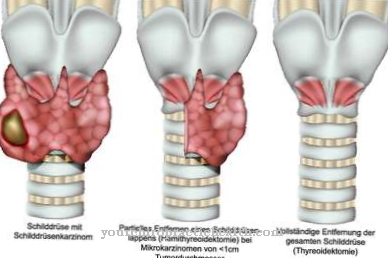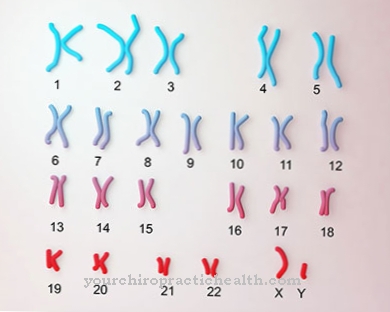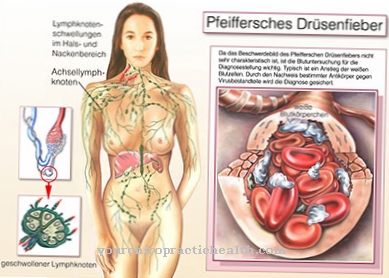Under respiratory alkalosis one understands an increase in the pH value to above 7.45, which occurs for respiratory reasons. The reason is always hyperventilation, i.e. breathing that is too fast or too deep.
What is respiratory alkalosis?
A balanced relationship between acidic and basic substances is one of the most important regulatory goals for the organism. If the pH value in the blood and in the body cells deviates upwards or downwards, the proteins denature and the metabolism quickly comes to a standstill.
In respiratory alkalosis, the pH value deviates upwards, towards the alkaline. In this case it is the respiration that is to blame.
causes
The context of the creation of a respiratory alkalosis and the resulting symptoms have meanwhile been well researched:
In many cases, hyperventilation arises from a psychological cause, i.e. due to panic attacks or psychological stressful situations. It mostly affects young girls in puberty or young adults. Furthermore, serious diseases of the respiratory system can lead to hyperventilation:
Inflammation of the brain, cirrhosis of the liver, blood poisoning or intoxication can irritate the respiratory center in the brain and thus lead to faster breathing. At the lung level, pulmonary embolism, pulmonary edema, pneumonia, or a severe asthma attack can result in faster breathing due to shortness of breath.
While with all these diseases more oxygen should be absorbed into the bloodstream (which is hardly possible after a certain saturation), carbon dioxide is exhaled at the same time. And the latter is the problem with respiratory alkalosis: CO2 is at the same time an important part of pH regulation. If too much of it is lost, it is supplied from acid components. This additional CO2 is in turn exhaled - the body loses acid and becomes alkaline.
If you want to understand the symptoms, you have to know that protons ("acids") and calcium ions in the bloodstream are bound to the same protein, albumin. If the blood now becomes alkaline, as in the case described above, protons are released from the albumin bond in order to compensate for this lack of acid. This frees up more space for calcium to bind, calcium ions go to the albumin, and the concentration of calcium freely dissolved in the blood decreases in turn.
However, the free calcium is an important stabilizer on cell membranes, especially of nerve and muscle cells. If the calcium level in the blood drops, the muscles become overexcitable: the typical muscle spasms in hyperventilation tetany are the result.
Symptoms, ailments & signs

© desdemona72 - stock.adobe.com
The symptoms of respiratory alkalosis depend on the strength and speed of the loss of carbon dioxide in the blood. Often the only sign observed is an increased respiratory rate or increased depth of breath. But both can also occur together.
There are two types of respiratory alkalosis. There is a chronic and an acute form. In the chronic form, there is compensation, so that there are usually no symptoms at all. However, sometimes there is a slight pressure on the chest or a feeling of lump in the throat. The acute respiratory alkalosis cannot be compensated and is therefore characterized, depending on the extent, by dizziness, confusion, tingling and numbness especially in the mouth area, seizures and brief loss of consciousness.
This entire complex of symptoms is also known as the so-called hyperventilation tetany. In particularly severe cases, the calcium concentration in the blood drops. This leads to an increase in neuromuscular excitability, which manifests itself in cramps and the position of the hands in the paws. The blood supply to the brain can be disturbed by the contraction of the blood vessels supplying the brain.
This then leads to temporary unconsciousness. Since respiratory alkalosis can occur as part of various underlying diseases, other symptoms are often present. However, if the underlying disease is successfully treated, the respiratory alkalosis will also disappear without any after-effects.
Diagnosis & course
A respiratory alkalosis manifests itself primarily through muscular overexcitability and cramps. A typical picture is the "paw position" of the hands, in which an involuntary flexion spasm takes place in the wrist and fingers. Parasitic sensations in the hands and feet also occur frequently and are also an expression of the relatively reduced calcium level.
The overall picture of psychogenic hyperventilation also naturally includes accelerated breathing and the history of the psychological stress that triggered the event (very typical: friend broke up, etc.). Unfortunately, those affected actually feel short of breath, as the excitement and respiratory alkalosis also cause a subjective feeling of chest tightness.
In a panic, the hyperventilator wants to breathe even faster, although the blood is actually maximally saturated with oxygen. You have to break this vicious circle.
Complications
Respiratory alkalosis is the result of hyperventilation, which can often occur as a complication of panic attacks and feelings of anxiety. However, hyperventilation often causes panic attacks as part of a vicious circle, which intensify the symptoms. There is a risk of a life-threatening condition that manifests itself in unconsciousness because the blood vessels that supply the brain are very narrow.
At the same time, so-called hyperventilation tetanus can occur. In the case of hyperventilation tetany, severe muscle spasms occur, which are characterized by a typical paw position of the hands with involuntary flexion spasms. These cramps are caused by a relative lack of calcium in the blood, which is caused by the high pH value.
Since respiratory alkalosis very often has psychological causes and is often triggered by stress, the intensification of hyperventilation can only be prevented by calming down the person concerned. However, hyperventilation is not always triggered by psychological causes. Sometimes it is a complication of an underlying medical condition such as cirrhosis of the liver, blood poisoning, encephalitis, pneumonia, pulmonary edema, pulmonary embolism, or simply a severe asthma attack.
Even then, the symptoms can worsen due to additional panic attacks. At the same time, however, there are also complications that are caused by the underlying diseases. In these cases, the hyperventilation that leads to respiratory alkalosis can only be prevented by treating the underlying disease.
When should you go to the doctor?
This disease must always be treated by a doctor. In most cases, there is no independent healing, so that the person concerned is always dependent on treatment by a doctor. Treatment with self-help means is usually not possible either. A doctor should be consulted if the patient has severe breathing difficulties. This can lead to very strong breathing that is very deep. The person concerned has to take a lot of breath.
Furthermore, a strong feeling of pressure on the chest can indicate the disease. In some cases, the person may feel a lump in their throat, which may also lead to numbness or dizziness. If these symptoms persist and do not go away on their own, a doctor must definitely be consulted. First and foremost, the general practitioner can be visited. Further treatment then takes place by a specialist. In acute emergencies, a visit to a hospital or the call of an emergency doctor is recommended.
Treatment & Therapy
It should be noted that this is not an actual calcium deficiency that could be treated with calcium, but rather a complex shift in the balance in the body. The cause must therefore be attacked: the breathing.
In the case of psychogenic hyperventilation, you hold a small bag the size of a sandwich bag in front of your mouth and let him breathe into it. The exhaled CO2 collects in the bag and is inhaled again directly in the next breath. At the same time, reassurance through persuasion is important - the hyperventilator has to be convinced that he is not really "unable to breathe" but that rapid breathing is the main problem. After a few minutes the carbon dioxide deficiency will be balanced and the feeling of shortness of breath disappears.
If hyperventilation is caused by serious diseases, these naturally have to be treated with emergency medicine. In these cases, in addition to the respiratory alkalosis (same path of origin), there is often actually a serious lack of oxygen, which should then be the main goal of therapeutic efforts.
You can find your medication here
➔ Medicines for calming & relaxationprevention
To a respiratory alkalosis To prevent this, it is important not to let the vicious circle of hyperventilation and subjectively perceived shortness of breath arise in the first place or to break it early. Anyone who knows a tendency to these symptoms can also hold a bag in front of them for a short time if they become excited. In case of doubt, however, the emergency services should always be called, who are used to dealing with such emergencies in a routine and calm manner and who can also recognize serious illnesses.
Aftercare
The symptoms of respiratory alkalosis depend on the strength and speed of the loss of carbon dioxide in the blood. Often the only sign observed is an increased respiratory rate or increased depth of breath. But both can also occur together. There are two types of respiratory alkalosis.
There is a chronic and an acute form. In the chronic form, there is compensation, so that there are usually no symptoms at all. However, sometimes there is a slight pressure on the chest or a feeling of lump in the throat. The acute respiratory alkalosis cannot be compensated and is therefore characterized, depending on the extent, by dizziness, confusion, tingling and numbness especially in the mouth area, seizures and brief loss of consciousness.
This entire complex of symptoms is also known as the so-called hyperventilation tetany. In particularly severe cases, the calcium concentration in the blood drops. This leads to an increase in neuromuscular excitability, which manifests itself in cramps and the position of the hands in the paws. The blood supply to the brain can be disturbed by the contraction of the blood vessels supplying the brain.
This then leads to temporary unconsciousness. Since respiratory alkalosis can occur as part of various underlying diseases, other symptoms are often present. However, if the underlying disease is successfully treated, the respiratory alkalosis will also disappear without any after-effects.
You can do that yourself
Respiratory alkalosis can be treated quite well in normal everyday life if the person concerned has received detailed information from their doctor.
With frequent hyperventilation, the first thing to do is to soothe the panic attack. With concentration exercises, the patients can counter the stress of fear and shortness of breath themselves. Nevertheless, the relatives should keep an eye on the people at risk and help quickly in an emergency to prevent respiratory failure. This also includes calling the emergency doctor if the breathing difficulties are very severe. Those affected have to take a deep breath themselves. But even if they are persuaded they can actively participate. Meditation and calming exercises reduce panic attacks.
It is also helpful in everyday life to have a bag with you. If necessary, those affected breathe into this bag. This compensates for the carbon dioxide deficiency and the acute problem is resolved. A kind of breathing training protects against shortness of breath and the panic of being unable to breathe. People who are anxious are often very prone to these symptoms. With the practical recommendations of the doctor, it is possible to counteract hyperventilation even in a state of excitement.



























